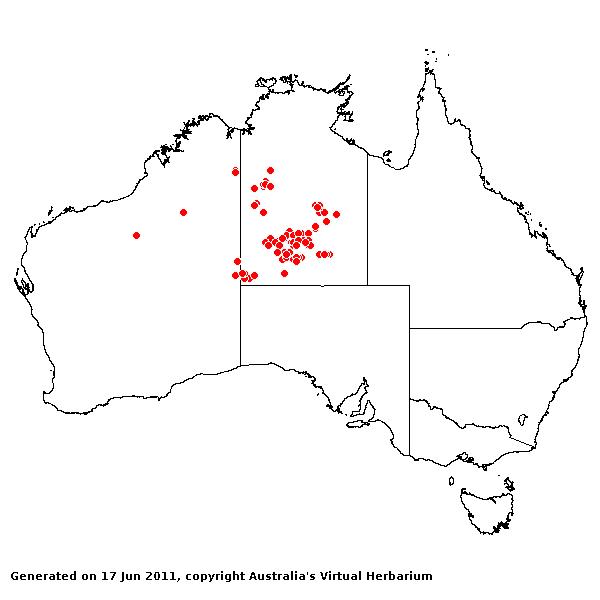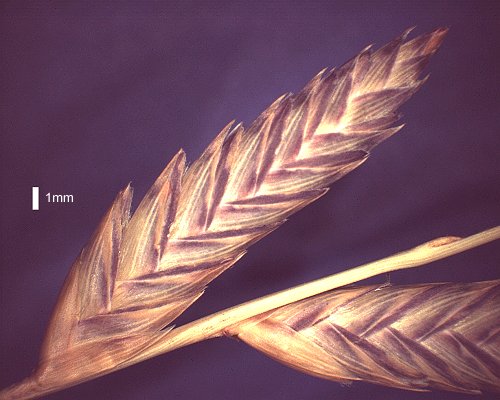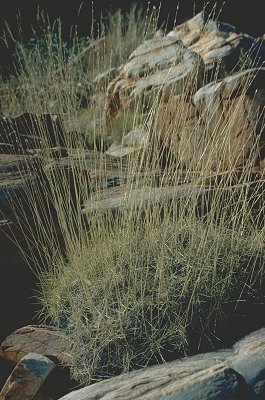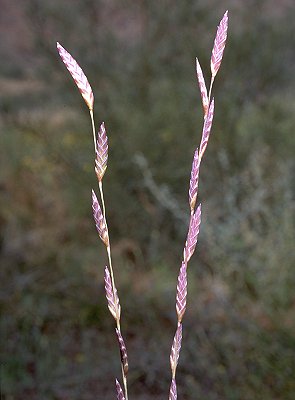Triodia spicata N. T. Burbidge. Austral. J. Bot. 1: 182 (1953).
Classification. (GPWG 2001) : Subfamily Chloridoideae. Triodeae.
Type of Basionym or
Protologue Information: Australia: Northern Territory: Napperby, about 100
mi NW of Alice Springs, 24 Jan 1950, S.L. Everist 4188 (HT: BRI, CANB).
Key references
(books and floras): [1981] M.Lazarides in J.Jessop (ed)., Flora of
Central Australia (445), [2002] D.Sharp & B.K.Simon, AusGrass,
Grasses of Australia.
Habit.
Perennial. Culms 15–100 cm tall. Leaf-sheath auricles absent. Ligule a fringe
of hairs. Leaf-blades aciculate, conduplicate, (2.5–)5–10(–19) cm long, 0.6–2
mm wide.
Inflorescence.
Inflorescence solid, a raceme or a spike. Racemes 1, 5–13(–26) cm long, 1–1.5
mm wide.
Spikelets.
Spikelets sessile. Fertile spikelets many flowered, with at least 2 fertile
florets (5–7), comprising 5–7 fertile floret(s), with diminished florets at the
apex, lanceolate or elliptic, laterally compressed or terete, 9–26 mm long.
Glumes.
Glumes similar. Lower glume lanceolate or ovate, scarious or cartilaginous or
coriaceous or indurate, without keels, 3–5(–9) -nerved. Lower glume surface
glabrous. Lower glume apex muticous or mucronate. Upper glume lanceolate or
ovate, 4–7 mm long, scarious or cartilaginous or coriaceous or indurate,
without keels, 3–7(–9) -nerved. Upper glume surface glabrous. Upper glume apex
entire, muticous or mucronate.
Florets.
Fertile lemma 5–8 mm long, without keel or keeled, 3(–9) -nerved. Lemma surface
indumented. Lemma apex entire, muticous or mucronate. Median (principal) awn
0.7–1 mm long overall. Lodicules present. Anthers 3.
Continental
Distribution: Australasia.
Australian
Distribution: Western Australia, Northern Territory.
Western Australia:
Hall. Giles, Fortescue. Northern Territory: Victoria River, Central
Australia North, Central Australia South.
Notes.
Distinguished by the infloresce nce of a few-flowered, prominently exserted
spike; tightly flowered, finally glossy straw-yellow spikelets; scarious or
cartilaginous to indurated glumes, lemmas and paleas; glabrous relatively short
glumes; entire, abruptly ovate, sparsely hairy, usually 3-nerved lemmas;
glabrous, relatively long paleas with winged, visible keels; narrow caryopsis,
plano-convex in profile; compact, often ring-forming habit; leaves usually with
long hairs on ligule, orifice and petiole, and with slender blades; prominently
hairy prophylla.
Chiefly
Central Australian, N.T. and nearby areas in W.A. Shallow, skeletal, stony and
gravelly soils on crests, slopes, outcrops, terraces and scree slopes of
sandstone, quartzite, granite and laterite hills, foothills and ridges; also
sandy flats; flowers Jan.-Nov.; fruits Jan.-Nov.






